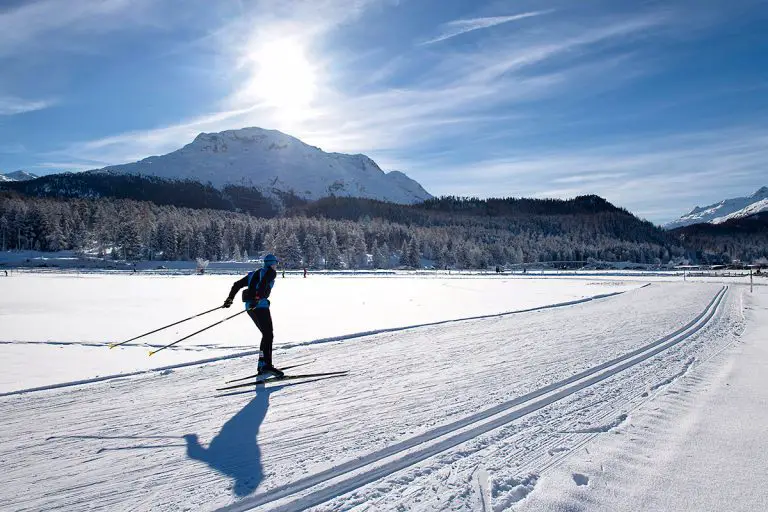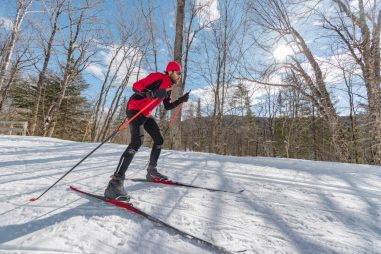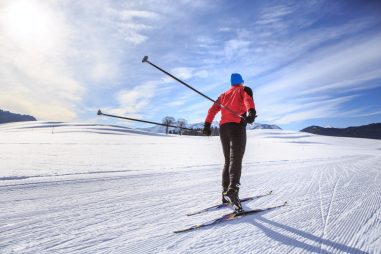You’ve probably seen how cool skate skiing looks and how fast skiers can go. If you thought that it’s a tough sport to do, you’re spot on. Skate skiing is one of the hardest sports to learn because of the physical effort, coordination, and balance it requires. But it’s also one of the best exercises you’ll ever have.
So don’t let the learning curve deter you. By getting into shape, with regular practice, and having a determined spirit, you’ll learn how to skate ski and get better at it in no time.
Is Skate Skiing Hard?
Yes, skate skiing is a challenging sport to learn especially if you’re not a regular skier. If you’re familiar with Nordic skiing, the main difference between skate skiing versus the classic Nordic skiing style is the technique.
Skate skiing is more akin to ice skating where your skis are pointed outwards and you alternately push off one side to diagonally glide to the other side. Aside from this, you also use your poles to add more power and gain speed.
When learning how to Nordic ski, pros recommend sticking to one style, either classic or skate. And generally, classic is the easiest to learn between the two.
How Hard Is Skate Skiing?
If you’re coming in with zero ice skating, skiing, or rollerblading experience, skate skiing is going to be challenging to learn. It’s highly recommended that you take lessons from the pros and don’t be surprised if they tell you right from the get-go that it’s not going to be easy.
Instructors often say that you need three Ps when learning to skate ski: patience, persistence, and practice. The learning curve is much steeper so it’ll take time to master the technique.
Why Is Skate Skiing So Hard?
Two things make skate skiing hard: the technique and the sport’s physical requirements.
- Technique: Skate skiing has unnatural movement patterns. It’s by no means alien-like, but it’s not a movement that you normally do like walking, running, or jumping. The side-to-side gliding together with pole pushing needs excellent total body coordination and balance.
- Physical requirements: Anyone will tell you that Nordic skiing, no matter what style, is one of the most physically demanding sports on the planet. If you want to do this regularly, you’ll need to be in great physical condition. Endurance levels should be above average and you need to be strong enough to consistently propel your body weight forward using your legs and arms using the poles.
Is Skate Skiing a Good Workout?
Skate skiing, as well as the other Nordic skiing styles, is widely considered one of the best workouts you’ll ever get. It’s a total body workout that will leave you breathless if you’re unprepared.
Beginners are always advised to get into shape before taking lessons. It’s physically demanding and the only way you’ll be able to really enjoy it is if you’re fit enough to ride. Skate skiing in poor physical shape can leave you exhausted in no time. Chances of injury are also higher.
How Good of a Workout Is Skate Skiing?
Skate skiing is a great workout because it targets all your major muscle groups including your cardiovascular system. You’ll need to be strong enough to propel your body using the skis and the poles.
It’s also a great endurance test that challenges you to do the movements continuously without losing gas quickly. Because once you’re gassed, ski time is over.
Overall, you burn a lot of calories and your whole body is challenged. If you do this regularly, you’ll be in great physical condition.
What Muscles Does Skate Skiing Work?
Skate skiing works your entire body’s major muscle groups, including your core and your heart. You’ll need lower body power to push your body forward and upper body strength so you can use your poles to propel you even further.
A strong core is critical to keep balance and control. And most importantly, you’ll need the endurance to do this movement continuously if you want to skate long distances.
How Many Calories Do You Burn Skate Skiing?
Because skate skiing is a high-intensity activity with dynamic movements, expect to burn a lot of calories. However, the calories you burn also depend on the other factors like:
- Age: You burn fewer calories as you age.
- Gender: Men generally burn more calories than women.
- Muscle mass/body fat: The more muscle mass you have, the more you burn.
- Fitness level: If you skate ski regularly, your body will get used to this activity and you’ll burn less compared to someone doing it for the first time.
How Many Calories Do You Burn in an Hour of Skate Skiing?
Skate skiing for an hour on flat terrain can burn at least 700 calories. You can burn more calories depending on the factors mentioned above. Additionally, terrain also plays a factor since walking or skiing uphill will burn additional calories.
How Do You Get in Shape for Skate Skiing?
You can get in shape for skate skiing by hitting the gym and playing other sports that engage the same muscle groups or have similar movements as skate skiing.
When in the gym, the focus should be on developing upper body, lower body, and core strength and power. A combination of compound and isolated exercises will help build strength and power efficiently.
Some of the best exercises you can do are:
- Romanian deadlifts: To build strong hamstrings and prevent ACL injuries.
- Single leg squats: For leg power to help you propel your body forward.
- Pull-ups: For shoulder and arm strength.
Core exercises are also critical. Your core is the source of your power and balance, so there’s no way you should skip this. When working out for skate skiing, the goal is to build functional strength and power and not gain muscle mass.
Endurance is the other key element in preparing your body for skate skiing. You can raise your endurance levels through running, biking, rowing, or swimming. Whatever sport you choose, you’ll need to put in consistent hours to train your body to endure long stretches of activity.
Is It Easy or Hard to Learn Skate Skiing?
For the uninitiated, skate skiing can be hard to learn. If you plan to take it on, it’ll do you good to take lessons from a trained professional. It has a steeper learning curve compared to the classic Nordic skiing style because of its dynamic movements that are similar to ice skating.
And it gets harder if you’re not in the best shape of your life. It’s a sport that requires power, strength, balance, control, and endurance. However, it will get easier with determination and practice.
How Do You Train for Skate Skiing?
Training for skate skiing involves preparing your body to perform its vigorous movements and through lots of practice.
You first have to be physically prepared to engage in the sport. It’s considered one of the hardest sports because of its technique and the strength and endurance to execute them over long distances.
Once you’ve got your body prepped, you’ll need to put in practice time. Like learning any new skill, mastery takes hours and hours of repetitive movement until it becomes muscle memory.
Can I Teach Myself to Skate Ski?
Yes, it’s possible to teach yourself how to skate ski. If you already know how to ice skate, then the learning curve might not be as steep. You can watch online tutorials and practice them on your own. However, you need to be aware that the chances of injuring yourself are also higher.
Because of this, it’s still advised to take lessons from the experts. This way, you’ll get guidance on the proper form and technique. You’ll have someone to correct any mistakes that can lead to injuries.
How Can I Improve My Skate Skiing?
You can improve your skate skiing skills through constant practice. Putting in time lets you get better with your technique. You can do skate skiing drills that improve specific aspects that you find challenging.
There are many different drills that you can find online or get from your trainers. For example, some drills work on your balance and timing. Have a problem using poles? Elastic band drills help you with your poling mechanics. You can also find drills on footwork, improving power, gliding, and more.




